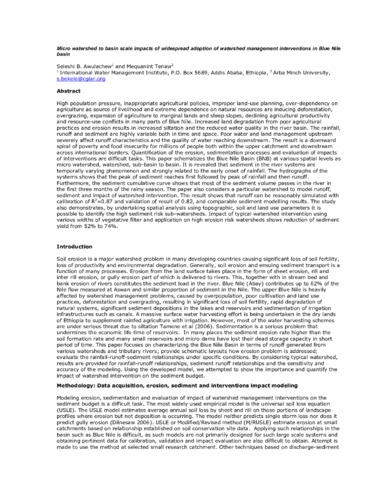Micro watershed to basin scale impacts of widespread adoption of watershed management interventions in Blue Nile Basin
Abstract
High population pressure, inappropriate agricultural policies, improper land-use planning, over-dependency on
agriculture as source of livelihood and extreme dependence on natural resources are inducing deforestation,
overgrazing, expansion of agriculture to marginal lands and steep slopes, declining agricultural productivity
and resource-use conflicts in many parts of Blue Nile. Increased land degradation from poor agricultural
practices and erosion results in increased siltation and the reduced water quality in the river basin. The rainfall,
runoff and sediment are highly variable both in time and space. Poor water and land management upstream
severely affect runoff characteristics and the quality of water reaching downstream. The result is a downward
spiral of poverty and food insecurity for millions of people both within the upper catchment and downstream
across international borders. Quantification of the erosion, sedimentation processes and evaluation of impacts
of interventions are difficult tasks. This paper schematizes the Blue Nile Basin (BNB) at various spatial levels as
micro watershed, watershed, sub-basin to basin. It is revealed that sediment in the river systems are
temporally varying phenomenon and strongly related to the early onset of rainfall. The hydrographs of the
systems shows that the peak of sediment reaches first followed by peak of rainfall and then runoff.
Furthermore, the sediment cumulative curve shows that most of the sediment volume passes in the river in
the first three months of the rainy season. The paper also considers a particular watershed to model runoff,
sediment and impact of watershed intervention. The result shows that runoff can be reasonably simulated with
calibration of R2=0.87 and validation of result of 0.82, and comparable sediment modelling results. The study
also demonstrates, by undertaking spatial analysis using topographic, soil and land use parameters it is
possible to identify the high sediment risk sub-watersheds. Impact of typical watershed intervention using
various widths of vegetative filter and application on high erosion risk watersheds shows reduction of sediment
yield from 52% to 74%

